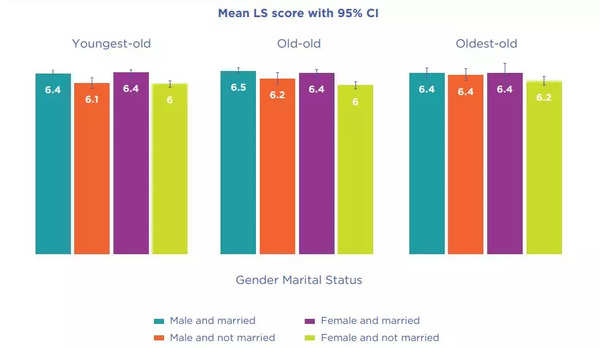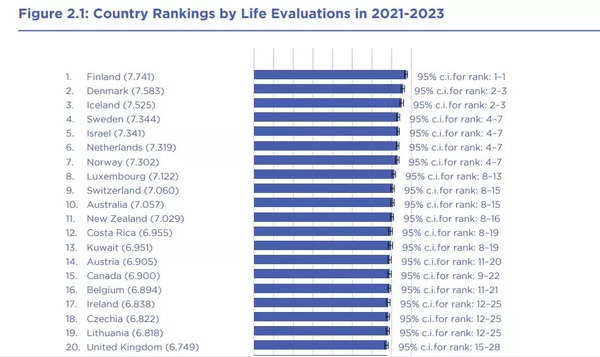Nordic nations continue to dominate the top rankings, with Denmark, Iceland, and Sweden following closely behind Finland. On the flip side, Afghanistan remains at the bottom of the list of 143 countries surveyed, facing ongoing humanitarian crises since the Taliban regained power in 2020.
For the first time in over a decade, the United States and Germany have slipped out of the top 20 happiest nations, landing at 23rd and 24th place respectively. Costa Rica and Kuwait have made their way into the top 20, ranking 12th and 13th.
The report highlights a shift where the happiest countries no longer feature any of the world’s largest nations, with only the Netherlands and Australia having populations exceeding 15 million in the top 10, and Canada and the UK with populations over 30 million in the top 20.
Notable changes in happiness levels have been observed since 2006-2010, with Afghanistan, Lebanon, and Jordan experiencing significant declines, while Eastern European countries like Serbia, Bulgaria, and Latvia have seen notable increases. The ranking of happiness is determined by individuals’ self-assessed evaluations of life satisfaction, along with factors such as GDP per capita, social support, healthy life expectancy, freedom, generosity, and corruption.
Jennifer De Paola, a happiness researcher at the University of Helsinki, cites Finns’ strong connection to nature and healthy work-life balance as key factors contributing to their life satisfaction. She notes that Finns have a different perspective on success, valuing aspects beyond financial gain, and benefit from a robust welfare society, trust in government institutions, low corruption levels, and universal healthcare and education.
This year’s report also highlights a trend where younger generations generally report higher levels of happiness compared to older age groups, except in North America, Australia, and New Zealand where happiness among the youth has declined since 2006-2010. Conversely, central and eastern Europe have seen happiness increase across all age groups during the same period, while Western Europe reports consistent happiness levels across generations. The report points out a concerning rise in happiness inequality globally, particularly among older individuals and in Sub-Saharan Africa, reflecting disparities in income, education, healthcare, and social support systems.
Where does India stand
India ranked 126, the same as last year, in the happiness index.
Factors such as marital status, social engagement, and physical health also influence life satisfaction among older Indians. Notably, satisfaction with living arrangements emerges as a critical factor, reflecting the strong desire among older Indians to age in place and maintain autonomy and social bonds. This study challenges the notion that age-related satisfaction is exclusive to high-income nations and underscores the importance of considering diverse factors affecting life satisfaction among older adults in India.
India’s older population ranks second globally, with 140 million individuals aged 60 and above, trailing only China. The growth rate of this demographic is three times higher than the country’s overall population growth rate. Despite this demographic shift being indicative of social and economic progress, understanding the factors influencing quality of life in old age remains crucial.

The report pointed out that older Indian men, particularly those in higher age brackets, presently married, and those with an education, tend to report greater life satisfaction compared to their counterparts. Among older Indians, factors such as dissatisfaction with living arrangements, perceived discrimination, and poor self-rated health are linked to lower life satisfaction.
Life satisfaction among older adults in India shows an interesting trend, contradicting the notion that age-related satisfaction is only prominent in high-income nations. While older age is generally associated with higher life satisfaction in India, older women tend to report lower satisfaction than men. Education level and social caste also play significant roles, with those with higher education and from higher social castes reporting greater life satisfaction. Additionally, satisfaction with living arrangements, perceived discrimination, and self-rated health emerge as primary predictors of life satisfaction among older Indians.
Older Indian women tend to report higher life satisfaction compared to men, despite facing more stressors and health challenges. Social support may play a significant role, as women often have broader social networks. Age, on the other hand, shows varied associations with life satisfaction. While common belief suggests a decline in satisfaction with advancing age, empirical studies suggest otherwise, with some suggesting increasing satisfaction with age due to factors like experience, adaptive strategies, and enhanced social and emotional regulation.
